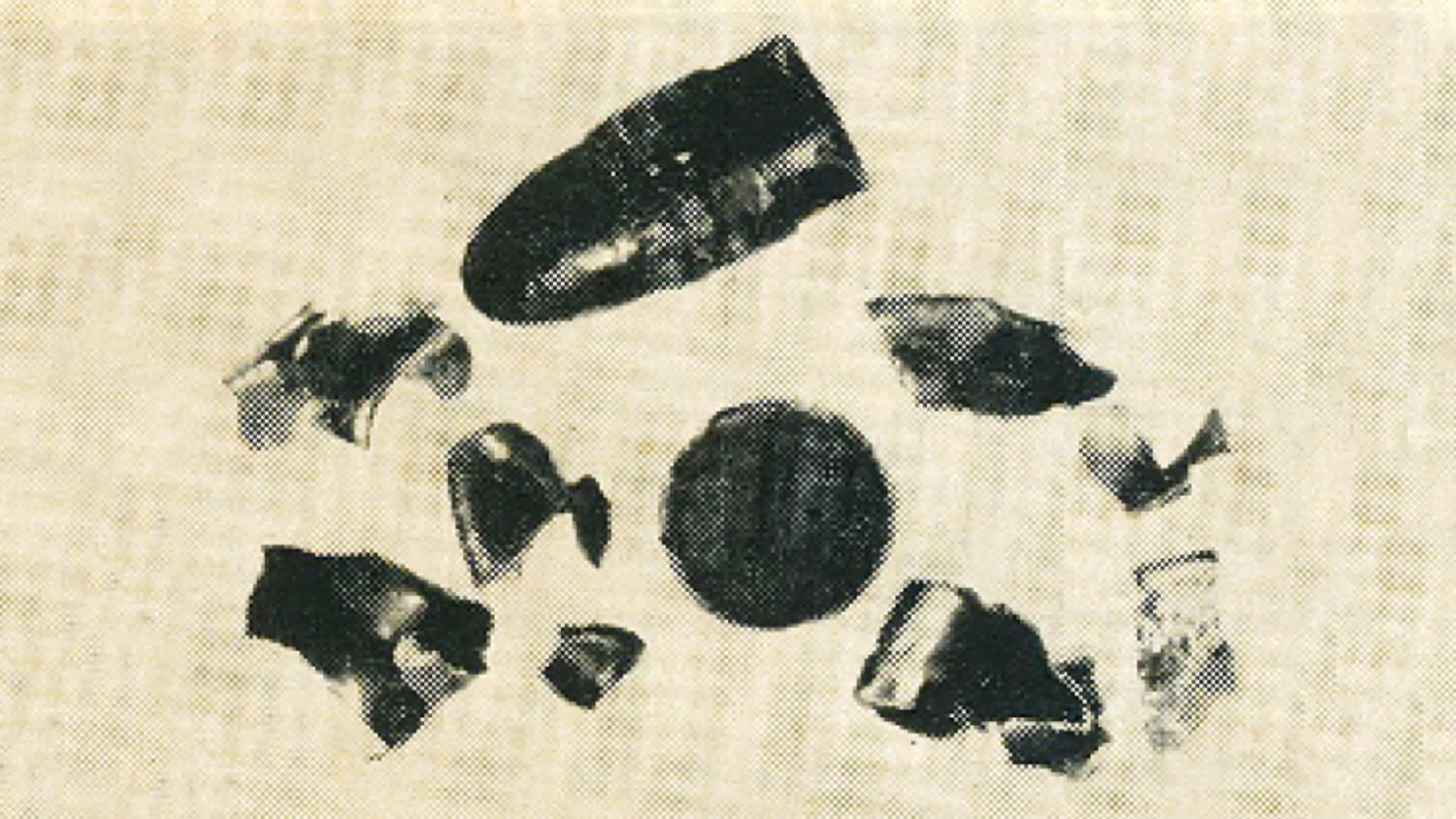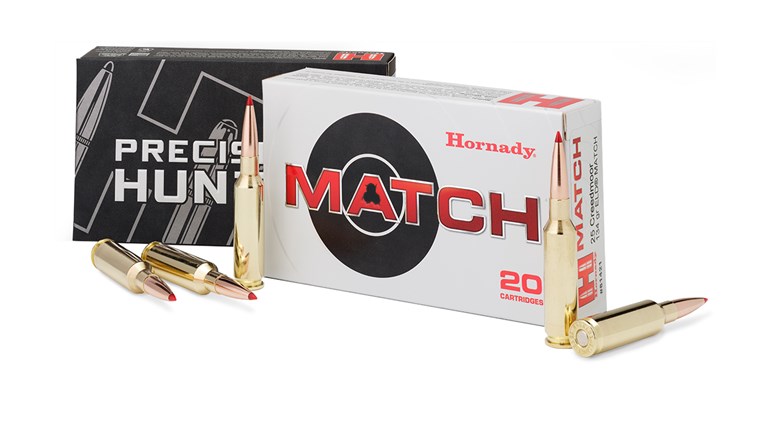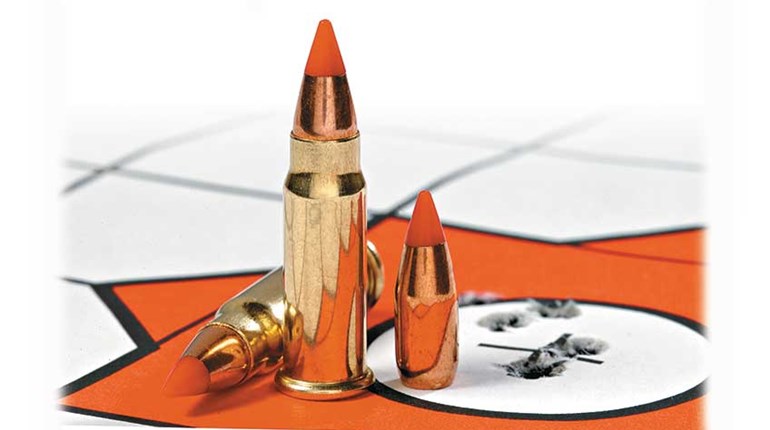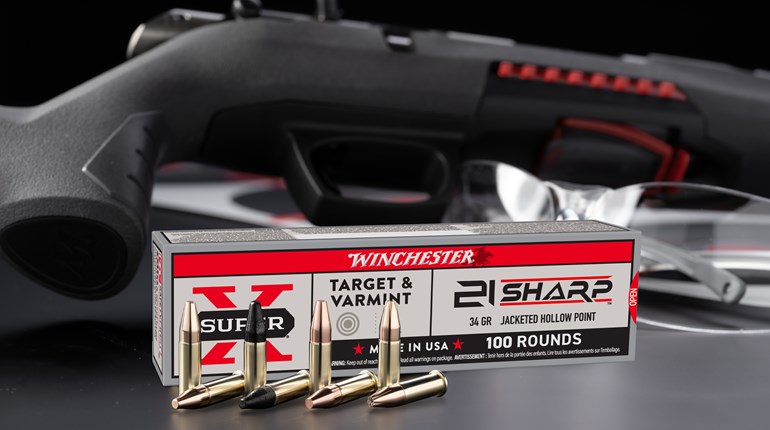
Above: The remains of Hi-Speed .22LR cartridge exploded by heat. These fragments were all stopped by one layer of corrugated cardboard.
From the September 1955 issue of American Rifleman, an article titled "Cartridge in the Fire" by Maj. Gen. J.S. Hatcher.
A newspaper story that crops up periodically is that which reports on a boy who has been wounded by a .22 or other caliber cartridge that went off in a trash fire or the like. However, all our experience indicates that while small fragments of the cartridge case, unconfined and set off in a fire, may be blown out with sufficient force to penetrate the skin, it is most unlikely that a bullet can get any dangerous velocity in this way.
The Washington D.C., daily papers of July 22, 1955, carried a story about two boys who were playing in a park when one of them was wounded in the neck. The boys first told the police that they heard a shot, and that one of them was hit. Later, under close questioning, they admitted that they had found a .22 cal. cartridge, and that one of them had held a match under it until it exploded. A piece of the cartridge case, about 1/8" x 1/16" in size, was removed from the boy's neck.
Frequently the story about the cartridge in the trash fire may originate when a youngster who has been forbidden to play with guns happens to wound himself or one of his friends, an an attempt is made to cover up.
If a bullet is taken from a victim of what is alleged to be a "cartridge in the fire" accident, look for rifling marks. If they are found, obviously the bullet came from a gun and not from a trash fire.
We have experimented on this subject many times, but to show again just what may be expected, we tried the following:
(A) A Remington Kleanbore Hi-Speed .22LR cartridge was placed on its base, bullet pointing up, in an electrically heated pot used for melting lead, and the pot was covered with an ordinary corrugated cardboard box, and the current turned on. After a few minutes the cartridge exploded with a loud bang. The bullet made a shallow dent in the cardboard.
(B) The experiment was repeated with a Western Super-X .22LR cartridge, with the same result.
(C) The experiment was repeated with a Remington Rocket .22 short. This has a very light bullet, and a big charge of powder, so the chance of a dangerous bullet velocity is greater. The cardboard sheet was laid directly on the opening of the lead pot. Same result—no penetration of the cardboard—only a shallow dent.
(D) Using a Remington HiSpeed Kleanbore .22LR cartridge, we placed a block of "BearMuscle" synthetic flesh over the mouth of the lead pot. No marks were made on the "BearMuscle," which is supposed to have the same resistance to bullet penetration as flesh does.
These experiments showed that in none of the tests did a .22 bullet acquire enough velocity to be dangerous. However, we have always thought that the brass fragments of a cartridge case could be more dangerous than a bullet under these circumstances, as the brass, being lighter, would get more velocity.
An ordinary pasteboard match, of the type found in book matches, will burn for about 20 seconds before reaching the fingers. Therefore it would be possible for a boy to lay a .22 cartridge down and hold the flame of a match to it for about 20 seconds, which is quite long enough to set it off.
We tried to duplicate the reported conditions of the accident as follows:
(E) We suspended a .22LR Remington Kleanbore HiSpeed cartridge by looping a thin wire around the case just behind the bullet. We then arranged a small birthday candle so it could be pushed precisely under the cartridge rim. We placed a corrugated cardboard box over the set-up and then pushed the lighted candle into position, at the same time starting the stopwatch. The cartridge exploded in just 10 seconds. The bullet made a very slight dent in the cardboard, and the edge just broke the far side of the cardboard. Had this fragment struck flesh, it would have broken the skin.
(F) The experiment was repeated with a Remington Rocket .22 short, which has a very light bullet with a normal muzzle velocity of 1600 fps. It took about 15 seconds to go off.
The bullet made a deep dent, about halfway through the 1/8" corrugated cardboard. The head of the cartridge case made a dent about half as deep as that of the bullet, or about 1/32" deep. Two slivers of brass from the case broke the far surface of the cardboard, or made an edgewise penetration of about 1/8" of cardboard. The main piece of the case struck a small piece of wood that was lying inside the cardboard box. This was about 4" from the explosion. The flattened piece of brass penetrated the board about 1/16" and stuck in it. Such a fragment would have broken the skin, and would be dangerous to eyesight. However, at a few feet distance its velocity would have been much less, and the chances are that a person would not be injured by such a fragment unless he was close to the explosion.


































